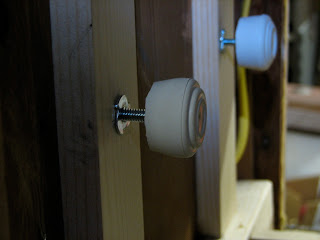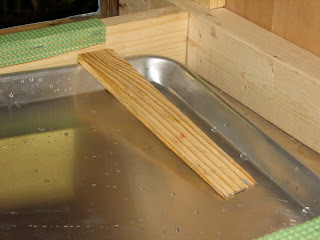 |
| I drilled some pilot holes to prevent the strip of wood from splitting and installed with screws. |
 |
| Here's a closer look. |
 |
| I didn't want the unit to slide around while I drove down the road, so I tacked down some nonskid material. |
 |
| Here's a closer look. |
 |
| I bought the correct sized tee nuts for the threaded glides. |
 |
| Drilled a hole for the tee nut to fit into the side framing. The tape on the drill bit lets me drill to the correct depth. I didn't want to drill through the side panel. |
 |
| I hammered the tee nuts into the side framing and screwed the glides into the nuts. |
 |
| I used a hole saw bit to drill the hole for my drain. The size of the bit is determined by the diameter of the drain pipe shown a couple of picture down. |
 |
| Drilled the hole. |
 |
| A closer look. |
 |
| Here I've placed the drain assembly in the hole I cut in the jelly roll pan. |
 |
| Then I tightened the nut down onto the rubber washer and the plumbers putty. |
 |
| Here's the view from the top. |
 |
| Here's the view from the bottom. |
 |
| I placed the drain pan where its going to go and shined a light down the drain. |
 |
| This showed me where I need to drill the hole in the floor for the drain line to exit. |
 |
| I drilled the correct sized hole through the floor of the trailer for the drain. |
 |
| Here's a close up of the wood shim and the cable clips. |
 |
| Another picture. You can see the drain on the right side going out the floor. |
 |
| This a picture of the hose running under the trailer. I didn't want water dripping on the door side of the trailer, so I ran it to the other side of the trailer. |
 |
| The end of the hose. |
 |
| I drilled the center out of a brass end cap and got a filter to screw into the end of the hose to keep bugs from building nests in it and blocking it up. |
 |
| Here you can see the screen in the end cap. |
 |
| Installed and draining. |









Very nice tutorial and easy for even me to understand. I am keeping this in my Shasta files. Is the air conditioner where the furnace was?
ReplyDeleteDragonfly
Have you any idea how I can remove the moldy looking crud off of the outside of my Shasta?
ReplyDeleteThis comment has been removed by the author.
ReplyDeleteI like to read your post heavy duty pneumatic casters & total lock casters
ReplyDelete